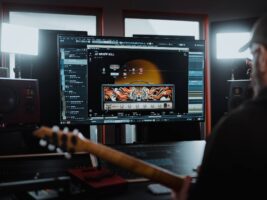
I tried using an AI-powered amp and effects suite to create my guitar sound for me – here’s what happened
Ad feature with Positive Grid
The guitar world is a place where true innovation often feels hard to come by – after all, a lot of the technology used to make guitars, amps and effects do what they do is many decades old.
Positive Grid has been trying to change that in recent years, and the brand’s revolutionary Spark smart amp has changed the game for thousands of guitar players who want to streamline and simplify their practice routine.
Now the brand is looking to make the tone-sculpting experience even more frictionless in its impressive new amp and effects software suite, Project: BIAS X – and it’s doing it with the help of 2025’s main character: AI.
One of the most common complaints about any kind of comprehensive amp and effects product is that the sheer volume of options can act as a hindrance to creativity. Option paralysis is a real thing, and how often have we got distracted auditioning different amps and effects instead of actually making music? It can be fun, but it’s not always productive.
Image: Positive Grid
As you’d expect, BIAS X is a hugely powerful tool for in-the-box guitarists, offering over a hundred brilliantly modelled amps, cabs and effects, and all the signal-routing options you could dream of.
You could spend many hours exploring all the different sounds that are available. But for those who want to get down to it, BIAS X adds something potentially revolutionary – a chatbot-style AI Assistant that will take your prompts and attempt to turn them into the guitar sound you’re looking for in seconds.
I don’t know about you, but even as an experienced BIAS user, I often find there’s a gap between the tone I envision in my head and the one I’m able to create – especially when Im stepping outside of my musical comfort zone.
Could BIAS X’s AI Assistant help me dial in the sound I’m looking for more easily and accurately than I could on my own? I was keen to find out, so I took the plunge?
Image: Positive Grid
How do you use the AI Assistant to create tones in BIAS X?
If you’ve been on the internet at all in the last year or so, you’ll probably have had some conversations with an AI agent, and the chat window popup in BIAS X is reassuringly familiar if you have.
Rather than answering your inane questions like ChatGPT, however, BIAS X’s AI Assistant has the much more worthwhile task of taking your user prompt and using its machine learning to build a signal chain from its myriad options. Once that’s done, you can check it out and then manually tweak and refine parameters to your taste.
As Guitar.com’s resident high-gain aficionado, my first port of call is to see how the AI Assistant can handle some crushing metal tones. There are plenty of amazing classic metal amps in BIAS X, so my hopes are high.
As with any AI prompt, I find it helps to be as specific as possible to get good results – “Give me a thrash metal tone” is not likely to yield exactly what you’re after for example, given the huge scope of that particular request.
Instead, I drill down: “Give me a high-gain tone for thrash metal,” I write. “Use a gate to limit unwanted noise, and make sure it has enough clarity so I can hear many notes in quick succession.”
I wait in quiet anticipation as the Assistant tells me it is ‘dialling it in’, and barely 10 seconds later I’m presented with a shiny new preset based on my request. This is a lot quicker than building it yourself.
To my great pleasure, the tone it gives me is a gnarly, heavily driven but not muddy sound – it’s frankly, mix-ready. The only thing I really have to do is tweak BIAS X’s global gate to reduce some heavy noise, but that may be more to do with my input level than anything fundamental about the AI-generated tone itself. Did I say it did this in 10 seconds?
A big tick for metal then, but how will the AI Assistant handle something a little more nuanced – like a crunchy blues-ready lead or a delicate and immersive clean for arpeggios? And what happens if I dial back on my level of detail in the prompt?
Keeping it simple this time I simply ask, “Give me a crunchy blues lead tone” and instantly you can tell the difference. While the basic result it provides me sounds good, it definitely needs a bit of refinement to get it to where I need it to be. It’s a touch wooly for my tastes, and the mids need scooping.
Thankfully, the AI Assistant exists in a continuous chat window, so I can ask it to make whatever refinements I desire. “Keep everything the same, but apply some subtractive EQ to the 400 – 600 Hz range to reduce grating peaks,” I tell it.
And voila, not 10 more seconds later, I’m served up a refined blues tone based on more than one of my prompts that sounds so good, and has me jamming for long enough for me to forget I’m working right now on writing this article.
My only real hiccup occurs the first time I ask for a clean tone – the Assistant generating a tone that’s significantly quieter in level than the previous two generated. Again, this would be an easy enough fix, but out of interest I simply ask the same prompt again.
The power of the AI inside means that these steps are not predetermined – so there’s every chance that the Assistant will output something different each time. Second time out, I’m delivered a gorgeously ethereal and reverb-washed clean tone that’s good to go.
It’s also worth noting that in my weeks with BIAS X, the quality of response from the Assistant has improved significantly with each software update pushed out pre-release. It’s a good sign that this will get even better over time.
It’s not just about text either…
What’s more, text-to-tone is just one of two principal ways the AI Assistant can help you achieve the sound you’re after. The other, ‘music-to-tone’, is perhaps even more exciting – as it allows you to upload an audio file, which BIAS X then analyses and delivers a guitar tone based on what it hears in the track.
Giving it a go myself, I uploaded an mp3 of a royalty-free track which begins with a riff, followed by a more full instrumental. I’m asked which snippet of the song I want BIAS X to analyse – it’s generally more successful if you choose a section with less instruments surrounding the guitar.
Once again, in 10 seconds or less delivers me four presets to choose from. I did notice that these presets were often quite different, but given that the AI is trying to account for the all-important guitar-shaped variable, that’s probably for good reason. Ultimately, every time I’ve given this feature a go, at least one of the generated presets sounds scarily like the original track.
Image: Positive Grid
So, do I really need an AI Assistant in my guitar software?
A lot of the conversation around AI at the moment is basically ‘Does X really need AI in it?’ but with something like BIAS X I can really see the user benefit.
The AI Assistant isn’t going to replace your need to have any kind of input in your tone-shaping endeavours – you still have to think and engage with what it’s spitting out in order for you to get the exact sound you want for your gear, playing style and needs.
Sure, you could create anything that the Assistant does yourself, but there’s no doubt that it gets you there a hell of a lot faster than the old-fashioned way. For me, it massively expedited the process of turning the sound in my head into a usable, functional guitar time, and let me focus on what really matters – making music.
Find out more about BIAS X at Positive Grid.
The post I tried using an AI-powered amp and effects suite to create my guitar sound for me – here’s what happened appeared first on Guitar.com | All Things Guitar.
Source: www.guitar-bass.net













